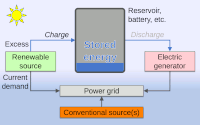Gravity battery

Have you ever dropped something and watched it fall to the ground? That's because of something called gravity. Gravity is a force that pulls things down towards the center of the Earth.
Now, imagine you had a big pile of heavy rocks up high on a platform. When you take those rocks and put them up high, they have what's called potential energy. Potential energy is like energy that's stored up and ready to be used.
If you take those rocks and let them fall down, they will release that potential energy and turn it into something else - like electricity. That's what a gravity battery does!
In a gravity battery, you have two big containers of heavy materials, like rocks or concrete. One container is up high and the other is down low. There's a tube connecting them, and inside the tube there's a turbine - kind of like a water wheel.
When you open a valve at the bottom of the high container, the heavy material starts to flow down through the tube and turn the turbine. The turbine spins and creates electricity.
As the heavy material flows down, it's releasing its potential energy and turning it into kinetic energy - the energy of movement that's moving the turbine.
Once all the heavy material is at the low container, you can pump it back up to the high container and start the whole process over again. That's how a gravity battery can keep making electricity for a long time!
So, in summary: a gravity battery is like a big pile of heavy rocks that can turn into electricity when it falls down through a turbine, and can be pumped back up to the top to start the process over again.
Now, imagine you had a big pile of heavy rocks up high on a platform. When you take those rocks and put them up high, they have what's called potential energy. Potential energy is like energy that's stored up and ready to be used.
If you take those rocks and let them fall down, they will release that potential energy and turn it into something else - like electricity. That's what a gravity battery does!
In a gravity battery, you have two big containers of heavy materials, like rocks or concrete. One container is up high and the other is down low. There's a tube connecting them, and inside the tube there's a turbine - kind of like a water wheel.
When you open a valve at the bottom of the high container, the heavy material starts to flow down through the tube and turn the turbine. The turbine spins and creates electricity.
As the heavy material flows down, it's releasing its potential energy and turning it into kinetic energy - the energy of movement that's moving the turbine.
Once all the heavy material is at the low container, you can pump it back up to the high container and start the whole process over again. That's how a gravity battery can keep making electricity for a long time!
So, in summary: a gravity battery is like a big pile of heavy rocks that can turn into electricity when it falls down through a turbine, and can be pumped back up to the top to start the process over again.
Related topics others have asked about:
